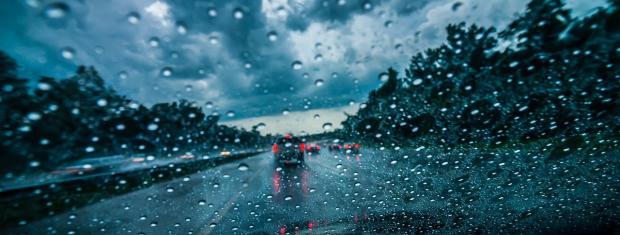
Top 6 Spring Driving Hazards
We can finally breathe a sigh of relief – no more commuting through treacherous ice and snow! Although the weather might be looking up, every season comes with its fair share of driving hazards. Sure, we don’t have to stress about getting stranded in freezing temperatures, but we do have to worry about these items in the spring:
1. Wet Roads & Flooding
You know what they say, April showers bring May flowers! Spring is known for increased rainfall, meaning slippery road conditions and potential flooding. The Federal Highway Administration estimates that nearly 73% of weather related traffic accidents occurred on wet roads. Be mindful of these hazards as you prepare for your commute.
Hydroplaning
Hydroplaning occurs when a vehicle starts sliding uncontrollably due to the tires encountering more water than the treads can displace. This loss of traction causes the driver to lose control of the vehicle and possibly end up in a crash. The greatest potential for hydroplaning usually occurs within the first ten minutes of rainfall. Here are some tips to keep in mind to avoid hydroplaning:
- Slow down – while hydroplaning can occur at any speed, you are more susceptible to losing control at higher speeds.
- Turn off cruise control – cruise control makes hydroplaning worse because it keeps your vehicle going at a constant speed when it comes into contact with water, making it difficult to regain control of your vehicle. Using cruise control can also create the “hitting the brake” reaction once you lose control, sending your vehicle into even more of an uncontrollable slide.
- Avoid puddles – keep an eye out for water accumulations on the road and do your best to avoid them at all costs. If your vehicle begins to skid, don’t panic. Avoid quick turns and hard braking. Ease off the gas and gently apply the brakes while steering straight ahead or into a safe open area.
Turn Around, Don’t Drown
A mere 6 inches of fast-moving flood water can knock over an adult, and 12 inches of rushing water can carry away a small car. If you cannot see the road underneath flood waters, turn around. It is NEVER safe to drive or walk through flood waters.
Not only are you putting yourself in danger, but your vehicle will likely stall which could cost you thousands of dollars to repair. Often times, a vehicle that stalls in flood waters becomes totaled because water makes its way into your engine.
2. Potholes

The freezing and thawing of moisture on our roadways throughout winter often creates significant potholes when spring arrives. Poyholes have been known to cause flat tires, bent rims and sometimes they can even damage your vehicles suspension. Here are some tips to protect your vehicle from pothole damage this spring:
- Ensure your tires are properly inflated - and under-inflated tire might not have enough resistance to withstand the impact of a pothole.
- Maintain a safe following distance - Leave extra room between your vehicle and the car in front of you so it's easier to spot upcoming potholes.
- Avoid impact or slow down - Only when traffic permits, do your best to straddle the pothole or avoid it entirely.
3. Hail
When falling precipitation, freezing cloud temperatures and strong updrafts create hail, it makes driving very dangerous. Hail not only obstructs your visibility, it can severely damage your vehicle while driving. Take these steps to arrive at your destination safely:
- Turn on low beams
- Decrease your speed
- Get off the road if you can do so safely. The impact speed of hail is greater on a moving object, so your car is at greater risk of damage when it's traveling forward. If possible, pull into a parking garage, a gas station canopy, under an overpass or any other place that offers shelter for your car.
- Be mindful of other drivers around you and increase your following distance by 3X.
- Stay inside your vehicle. Fast-moving hailstones can break glass and dent metal, so they can injure you and your passengers too. If possible, lie down with your face away from the window. If you have a coat or blanket in the car, use it to protect your face and head in case of flying glass.
4. Increased Animal Activity

For most creatures spring means increased warmth and daylight, and these two elements are known to increase animal activity. Arising from winter sleep, migrating, breeding – the warmth of spring makes plants grow and food become more abundant. With more critters scurrying across roadways, keep these tips in mind:
- Pay close attention to road shoulders at dawn and at dusk
- Scan the road for animal crossing signs were activity is known to be increased
- Use your high beams, only when traffic permits
- Brake, but don’t swerve. If you are going to collide with a creature you should brake firmly but stay in your lane.
- Blow your horn to try and scare the animal off of the roadway
5. Motorcyclists
Warm weather doesn’t only bring out the animals, it also brings out motorcyclists. Naturally, motorcyclists are at an increased risk of injury during a collision. We must all do our part to stay safe on the roadway, including sharing it appropriately with motorcyclists:
- Always check your blind spots
- Be extra careful when passing
- Maintain a safe, increased, following distance
- Be cautious in severe weather, as motorcyclists are more difficult to see
- Notify motorcyclists of your intention to turn sooner
- Intersections are dangerous, always follow safety protocol when approaching them
- Watch for turning motorcycles, since some of them may not have signals
- Take a second look when turning left
6. Pedestrians
Everyone has long anticipated ditching their winter blues and heading outside. Children playing, cyclists, joggers – expect more pedestrians to be active on the roads throughout warmer weather. 6,000 pedestrians were killed in motor vehicle crashes in 2017. Don’t increase that statistic, keep these tips in mind instead:
- Stop for pedestrians at crosswalks
- Slow down and obey the posted speed limit
- Yield to pedestrians and cyclists when turning
- Look before opening your door
- Be cautious when passing stopped vehicles
- Allow three feet when passing cyclists
Spring is a great time to discuss your auto insurance policy with your local Rockford Mutual Insurance Agent. You might want to consider adding Comprehensive or Collision coverage to your policy for additional protection against things like collision with an animal, damage from a storm, crashing into a pothole and much more!


